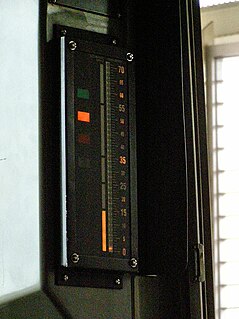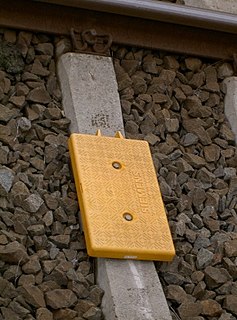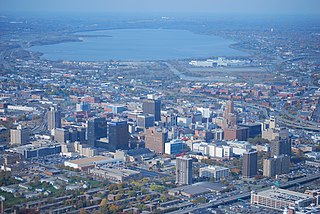
In railway signalling, an interlocking is an arrangement of signal apparatus that prevents conflicting movements through an arrangement of tracks such as junctions or crossings. The signalling appliances and tracks are sometimes collectively referred to as an interlocking plant. An interlocking is designed so that it is impossible to display a signal to proceed unless the route to be used is proven safe.

Cab signaling is a railway safety system that communicates track status and condition information to the cab, crew compartment or driver's compartment of a locomotive, railcar or multiple unit. The information is continually updated giving an easy to read display to the train driver or engine driver.

Centralized traffic control (CTC) is a form of railway signalling that originated in North America. CTC consolidates train routing decisions that were previously carried out by local signal operators or the train crews themselves. The system consists of a centralized train dispatcher's office that controls railroad interlockings and traffic flows in portions of the rail system designated as CTC territory. One hallmark of CTC is a control panel with a graphical depiction of the railroad. On this panel, the dispatcher can keep track of trains' locations across the territory that the dispatcher controls. Larger railroads may have multiple dispatcher's offices and even multiple dispatchers for each operating division. These offices are usually located near the busiest yards or stations, and their operational qualities can be compared to air traffic towers.

The Cambrian Line is a railway that runs from Shrewsbury to Aberystwyth and Pwllheli, both on the west coast of Wales. The line from Dovey Junction to Pwllheli is sometimes called the Cambrian Coast Line.

General Railway Signal Company (GRS) was a supplier of railway signaling equipment, systems and services in the Rochester, New York area. The company was established in 1904 and became part of Alstom Transport in 1998. GRS was a member of the Dow Jones Industrial Average from 1928 to 1930.

Positive train control (PTC) is a system of functional requirements for monitoring and controlling train movements and is a type of train protection system. The term stems from control engineering. The train is only allowed to move in case of positive movement allowance. It generally improves the safety of railway traffic.

An Eurobalise is a specific variant of a balise being a transponder placed between the rails of a railway. These balises constitute an integral part of the European Train Control System, where they serve as "beacons" giving the exact location of a train as well as transmitting signalling information in a digital telegram to the train.

Advanced Civil Speed Enforcement System (ACSES) is a positive train control cab signaling system developed by Alstom. The system is designed to prevent train-to-train collisions, protect against overspeed, and protect work crews with temporary speed restrictions. The information about permanent and temporary speed restrictions is transmitted to the train by transponders (Balises) lying in the track, coded track circuits and digital radio. It was installed beginning in 2000 on all of Amtrak's Northeast Corridor between Washington and Boston, and has been fully active since December 2015, a few months after the 2015 Philadelphia train derailment which it would have prevented.
Rail speed limits in the United States are regulated by the Federal Railroad Administration. Railroads also implement their own limits and enforce speed limits. Speed restrictions are based on a number of factors including curvature, signaling, track condition, the physical condition of a train, and the presence of grade crossings. Like road speed limits in the United States, speed limits for rail tracks and the trains that run on them use miles per hour (mph).
Hitachi Rail STS is an Italian transportation company owned by Hitachi with a global presence in the field of railway signalling and integrated transport systems for passenger traffic and freight operations. Hitachi Rail STS plans, designs, manufactures, installs and commissions signaling systems, components and high technologies for the management and control of newly built or upgraded railways, transit and freight lines worldwide.
Dark territory is a term used in the North American railroad industry to describe a section of running track not controlled by signals. Train movements in dark territory were previously handled by timetable and train order operation, but since the widespread adoption of two way radio communications these have been replaced by track warrants and direct traffic control, with train dispatchers managing train movements directly. Today most dark territory consists of lightly used secondary branch lines and industrial tracks with speeds ranging between 25 miles per hour (40 km/h) and 40 miles per hour (64 km/h); however, there do exist a small minority of main lines that fall into the category.
ERTMS Regional is a simplified and low-cost variant of the European Rail Traffic Management System suitable for train control on lines with low traffic volumes. It is intended to reduce the amount of lineside and equipment required, thus reducing costs, increasing reliability and improving safety for track workers.
LOCOPROL has been a project to research the integration of satellite navigation into railway networks targeting low-density track lines. It is supposed to extend the ERTMS train protection systems. The partner project LOCOLOC was looking into cab signaling and speed control measures.

KLUB is the name of the modern Russian train control systems. The abbreviation "КЛУБ" stands for "Комплексное локомотивное устройство безопасности", Integrated Train Protection System. The most common variant is KLUB-U where the U stands for unified (унифицированный).
The European Rail Traffic Management System (ERTMS) is an initiative backed by the European Union to enhance cross-border interoperability and the procurement of signalling equipment by creating a single Europe-wide standard for train control and command systems.














